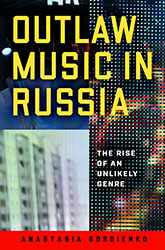|
Outlaw Music in Russia
The Rise of an Unlikely Genre
Anastasia Gordienko
The first full history of the Russian shanson
The Russian shanson can be heard on radio and television shows, at mass events like political rallies, and even at the Kremlin. Anastasia Gordienko provides the first full history of the shanson, from its tenuous ties to early modern criminals’ and robbers’ folk songs, through its immediate generic predecessors in the Soviet Union, to its current incarnation as the soundtrack for daily life in Russia. It is difficult to firmly define the shanson or its family of song genres, but they all have some connection, whether explicit or implicit, to the criminal underworld or to groups or activities otherwise considered subversive. Traditionally produced by and popular among criminals and other marginalized groups, and often marked by characters and themes valorizing illegal activities, the songs have undergone censorship since the early nineteenth century. Technically legal only since the collapse of the Soviet Union, the shanson is today not only broadly popular but also legitimized by Vladimir Putin’s open endorsement of the genre.
With careful research and incisive analysis, Gordienko deftly details the shanson’s history, development, and social meanings. Attempts by imperial rulers, and later by Soviet leaders, to repress the songs and the lifestyles they romanticized not only did little to discourage their popularity but occasionally helped the genre flourish. Gordienko also investigates the shanson as it exists in popular culture today: not divorced from its criminal undertones (or overtones) but celebrated for them. She argues that the shanson expresses fundamental themes of Russian culture, allowing for the articulation of anxieties, hopes, and dissatisfactions that are discouraged or explicitly forbidden otherwise.
 Anastasia Gordienko is an assistant professor of Russian and Slavic studies at the University of Arizona.
Anastasia Gordienko is an assistant professor of Russian and Slavic studies at the University of Arizona.
Praise
“A clear and entertaining overview of a vital, integral part of post-Soviet Russian culture—a joy to read.”
—Eliot Borenstein, New York University
“This fascinating book, both deeply researched and highly entertaining, provides valuable insights into Russian cultural history and should be required reading for all interested in the history of Russian popular song.”
—Karen Evans-Romaine, University of Wisconsin—Madison
“A rigorous examination. . . . [Gordienko] unearths many intriguing aspects of the shanson. Russophiles and musicologists will savor this impressive study.”
—Publishers Weekly
“A seminal work of simply outstanding scholarship. . . . Unique and highly recommended.”
—Midwest Book Review
“[Gordienko] is among the first to conduct in-depth research on [shanson]. The result is this detailed, extensively documented study.”
—CHOICE
“Vivid and engrossing. . . . The sophistication of [Gordienko’s] methodology—which is as likely to refer to Adorno and Habermas as it is to historians and sociologists of Russia—is lightly worn and informed by some fifteen years of close-up anthropological observation working in the world of Russian and Ukrainian broadcasting.”
—Slavonic and East European Review
“Wonderful and thoroughly engaging. . . . Breaks new grounds.”
—Slavic Review
“Gordienko makes a valuable and convincing argument for the tangible effects that popular music can have on politics and culture, rather than music only serving as a reflection of society for scholarly observation. It will surely be a foundational work.”
—The Soviet and Post-Soviet Review
Table of Contents
Contents
List of Illustrations
Acknowledgments
A Note on Translation and Transliteration
Introduction
1 Contextualizing the Shanson Phenomenon
2 Criminals’ Music from Its Origins to the Early Soviet Period: A Glorified Archetype
3 Soviet Underworld Music: From the Bolshevik Revolution through the End of the Stalin Era
(1917–1950s)
4 From Post-Stalinist Censorship to the Contemporary Mainstream: The Birth of the Shanson
5 The Shanson: Main Features and Tropes
6 The Shanson in Russia: From the Slums to the Kremlin
7 Turning Russia’s Immediate Reality into Song
Epilogue: The Shanson—Soundtrack to Russian Reality
Glossary
Notes
Bibliography
Index
|

Larger images
January 2023
LC: 2022013227
336 pp. 6 x 9
27 b/w illus.
|

